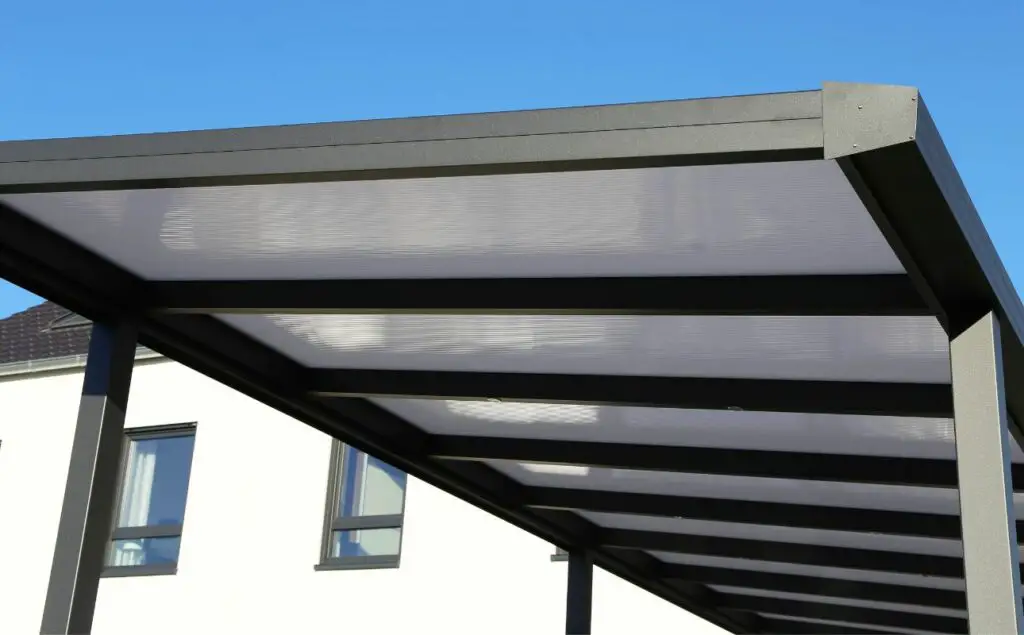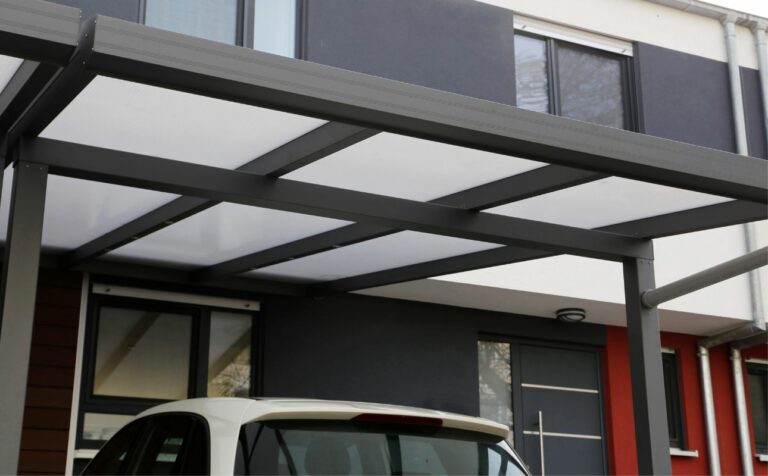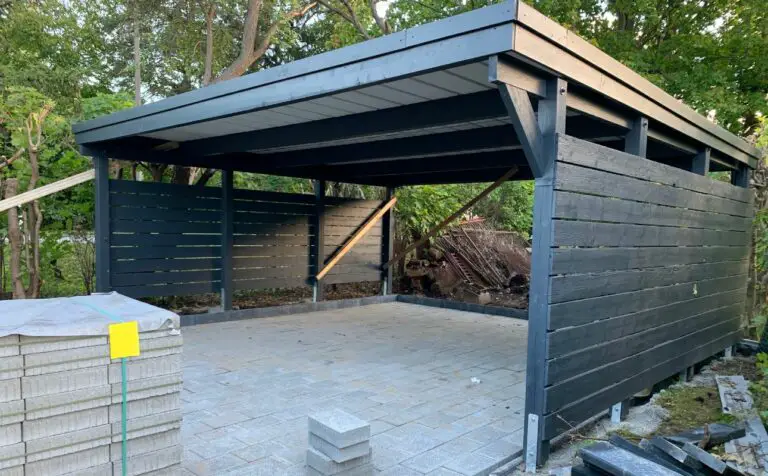Carports provide shelter to vehicles and other outdoor equipment, protecting them from harsh weather conditions such as rain, snow, and hail.
While carports are designed to offer protection against the elements, there is one question that often arises: do carports need gutters? Gutters play an essential role in channeling water away from the roof of a building.
This is done by collecting rainwater and directing it towards a designated drainage system. The absence of gutters can lead to water damage on both the exterior and interior parts of a building.

Importance of Gutters
Gutter materials are an important factor to consider, as they can affect the durability and effectiveness of the gutter system. Aluminum and steel gutters are popular choices due to their strength, while vinyl gutters offer a more affordable option with easy installation.
Additionally, the placement of gutters plays a significant role in their functionality. They should be installed at an angle that allows for water flow towards downspouts, which should be strategically placed away from the carport’s foundation.
Factors to Consider
When considering whether carports need gutters, several factors come into play.
- Rainfall intensity: The amount and intensity of rainfall in your area play a significant role in determining whether gutters are necessary for a carport. If you experience heavy rainfall or frequent downpours, gutters can help prevent excessive water accumulation around the carport, protecting both the structure and vehicles parked underneath.
- Roof design: The design of the carport’s roof also affects the need for gutters. A sloped roof that effectively channels water away from the carport may not require gutters. However, if the roof design allows water to collect or pool in certain areas, gutters can help redirect the water to a suitable drainage system.
- Surrounding landscape: If the carport is situated on a slope or near a higher elevation, water runoff from rain can flow down and accumulate around the carport. Gutters can help manage this runoff, preventing water damage to the carport and its foundation.
- Size and material of the carport: Larger carports with wider roof spans may collect and channel more water, making gutters necessary. Additionally, certain carport materials, such as metal or steel, may be more prone to water damage or rusting without proper drainage provided by gutters.
- Purpose of the carport: Consider how you intend to use the carport. If it is primarily used for parking vehicles, gutters can help protect your cars from getting soaked during heavy rainfall. Gutters can also prevent water from entering the carport, keeping the area dry and suitable for other uses, such as storage or outdoor activities.
- Local building codes and regulations: Check with your local building codes and regulations to determine if gutters are required for carports in your area. Some jurisdictions may have specific guidelines regarding the installation of gutters for structures like carports.
Types of Gutters
There are several types of gutters available, each with its own advantages and characteristics. Here are some common types:
- K-Style Gutters: K-style gutters are one of the most popular gutter styles. They have a flat bottom and a decorative shape that resembles the letter “K.” These gutters can hold a large amount of water and are known for their durability. K-style gutters are available in various sizes and materials such as aluminum, vinyl, and steel.
- Half-Round Gutters: As the name suggests, half-round gutters have a semi-circular shape, resembling a tube cut in half lengthwise. They are often made of aluminum or copper and are known for their classic, elegant look. Half-round gutters are generally easier to clean compared to K-style gutters, but they may not be able to handle large water volumes as effectively.
- Box Gutters: Box gutters, also known as square gutters, have a rectangular or square shape. They are often custom-made to fit specific requirements and are commonly found on commercial buildings or older homes. Box gutters require proper maintenance and regular cleaning to prevent debris buildup.
- Fascia Gutters: Fascia gutters are installed directly to the fascia board, which is the vertical board running along the roofline. These gutters are a convenient option for houses without eaves or overhangs. Fascia gutters can be made of various materials, including aluminum, vinyl, or steel.
- Seamless Gutters: Seamless gutters are custom-made on-site to fit the exact measurements of your home. They are made from a continuous piece of material, eliminating the need for seams and reducing the chances of leaks. Seamless gutters can be made from different materials, such as aluminum or copper, and are a popular choice for their clean and streamlined appearance.
- Vinyl Gutters: Vinyl gutters are lightweight, affordable, and easy to install. They are made of PVC (polyvinyl chloride) material and are available in various colors to match your home’s exterior. While vinyl gutters are low maintenance, they may not be as durable as metal gutters and can become brittle over time.
- Copper Gutters: Copper gutters are known for their aesthetic appeal and longevity. They develop a distinctive patina over time, giving a unique and classic look to a home. Copper gutters are durable and weather-resistant, but they tend to be more expensive than other gutter materials.
Installation Process
Professional installation of carports can be a wise choice for those who lack the necessary skills, tools, or time to complete the project themselves. A professional installer will ensure that the carport is installed correctly and meets all safety standards.
Professional Installation
Professional installation is highly recommended to avoid common mistakes that can lead to water damage or improper drainage. Hiring a professional ensures proper placement and secure attachment of gutters, downspouts, and other necessary components.
Additionally, cost comparison between DIY installation and professional installation should be considered. While DIY installations may seem more cost-effective in the short term, they can lead to costly repairs in the long run if not done correctly.
DIY Installation
While it is tempting to save money by doing it yourself, cost comparison between professional installation and DIY options must be considered.
Additionally, material options should also be factored in as some materials may require specialized tools and expertise for installation. It is important to note that without proper knowledge and experience, even the most straightforward home improvement projects can present challenges.
Potential Challenges
As with any home improvement project, the installation of gutters on a carport can present numerous challenges that require careful consideration and planning. Design options must be evaluated to determine which style best complements the existing structure, while cost considerations must be taken into account to ensure affordability.
The slope and size of the roof may require customized gutters or downspouts to properly channel water away from the carport and prevent damage. Moreover, selecting appropriate materials is crucial to ensure longevity and durability in adverse weather conditions.
Finally, proper installation techniques are vital for ensuring that gutters function as intended and do not cause further damage or safety hazards during heavy rainfalls or winds.
Maintenance and Cleaning
Regular maintenance and cleaning of the drainage system in a carport are essential to ensure proper functioning and prevent water-related issues. Here are some steps to follow for maintaining and cleaning the drainage system:
- Inspect the gutters and downspouts
Regularly check the condition of the gutters and downspouts in your carport. Look for any signs of damage, such as cracks, rust, or loose components. Ensure that the gutters and downspouts are securely attached to the carport structure.
- Clear debris
Remove any leaves, twigs, dirt, or other debris that may have accumulated in the gutters and downspouts. Debris can clog the drainage system and prevent proper water flow. Use gloves and a small trowel or scoop to scoop out the debris. Dispose of it properly.
- Flush the system
After clearing the debris, use a hose to flush water through the gutters and downspouts. This will help remove any remaining small particles or blockages. Start from one end of the gutter and work your way to the other, ensuring that water flows freely through the downspouts.
- Check for leaks
While flushing the system, keep an eye out for any leaks or water drips along the gutters and downspouts. Leaks can lead to water damage and should be repaired promptly. Use silicone sealant or gutter patching materials to seal any leaks or cracks.
- Trim vegetation
Trim any overhanging branches or vegetation near the carport that may contribute to debris accumulation in the gutters. This will help prevent excessive leaves and twigs from falling into the gutters and reduce the need for frequent cleaning.
- Consider gutter guards
Installing gutter guards or screens can help prevent debris from entering the gutters in the first place. These protective devices allow water to flow through while blocking leaves and larger debris. Gutter guards can reduce the frequency of cleaning but may still require periodic maintenance to remove smaller particles that accumulate on the surface.
- Monitor the drainage
During heavy rainfall, observe the water flow through the gutters and downspouts. Ensure that water is properly channeled away from the carport and its foundation. If you notice any pooling or standing water, it may indicate a drainage issue that needs to be addressed.
- Schedule professional inspections
Consider hiring a professional gutter cleaning and maintenance service at least once or twice a year. Professionals have the expertise and tools to thoroughly inspect and clean the drainage system, identify potential problems, and provide necessary repairs or replacements.
The Bottom Line
The presence of gutters on carports is essential in maintaining their structural integrity and preventing water damage.
Gutters help to channel water away from the carport’s foundation, which helps to prevent erosion and flooding. They also prevent water from seeping into the structure, causing moisture buildup that can lead to rotting or rusting over time.
Overall having gutters installed on your carport is beneficial in protecting your investment while improving its aesthetic appeal.





